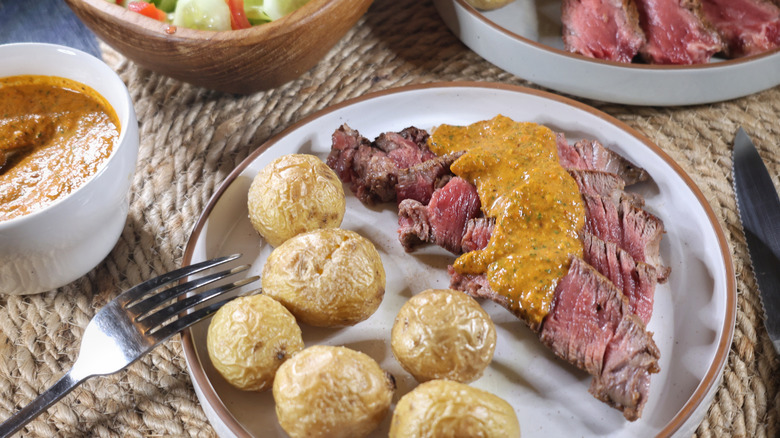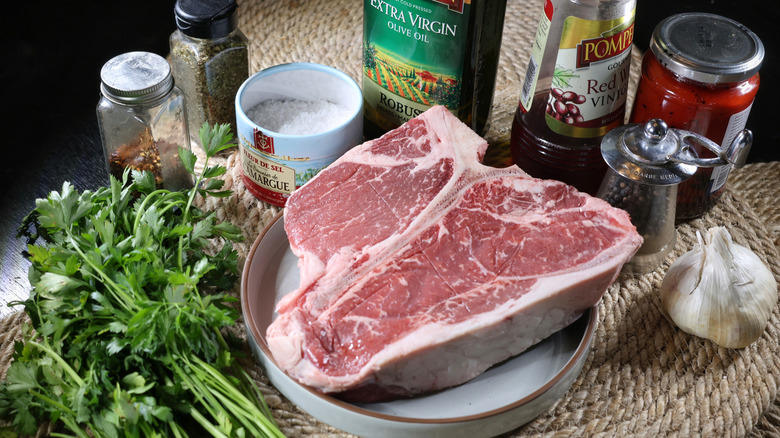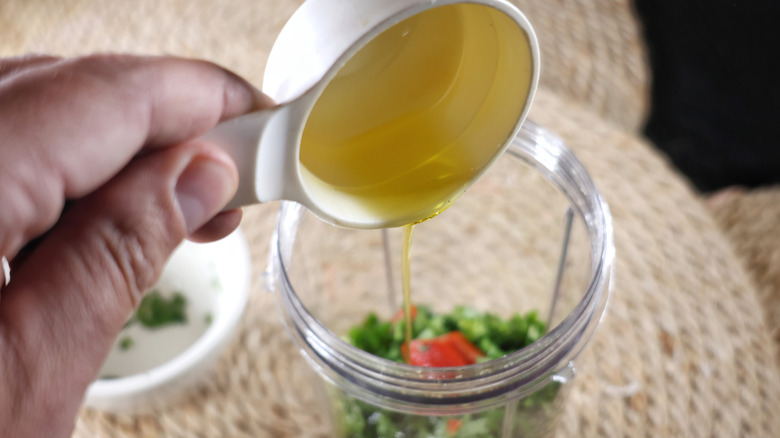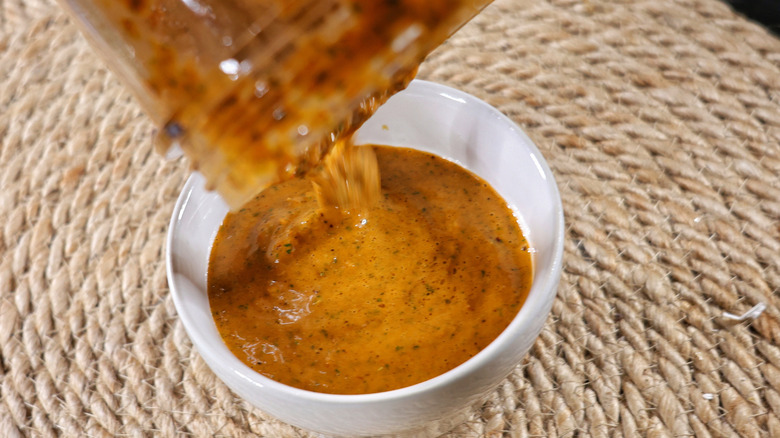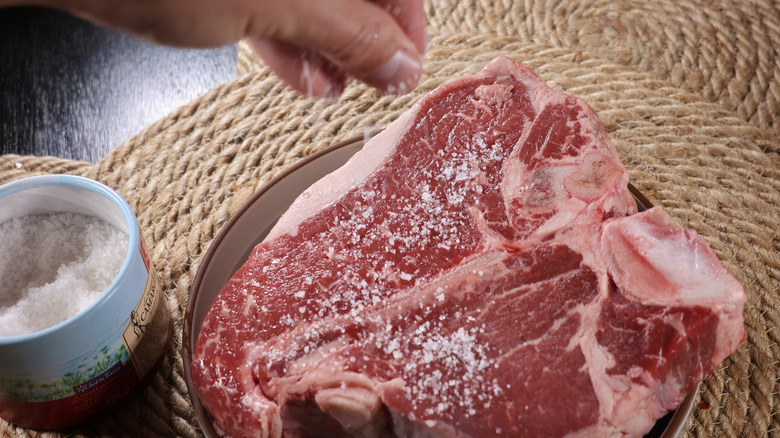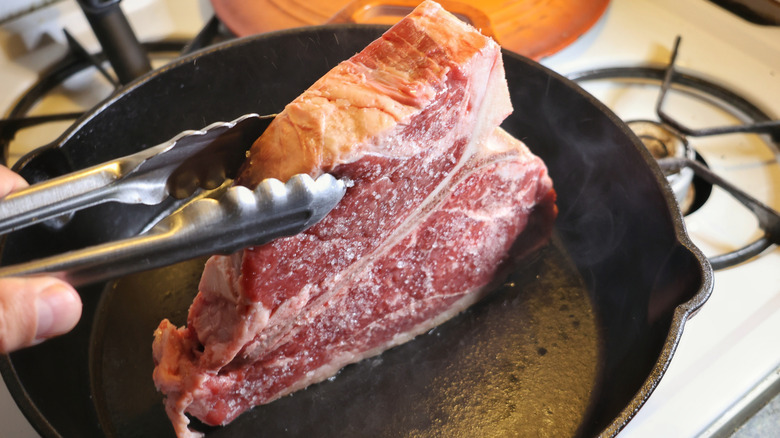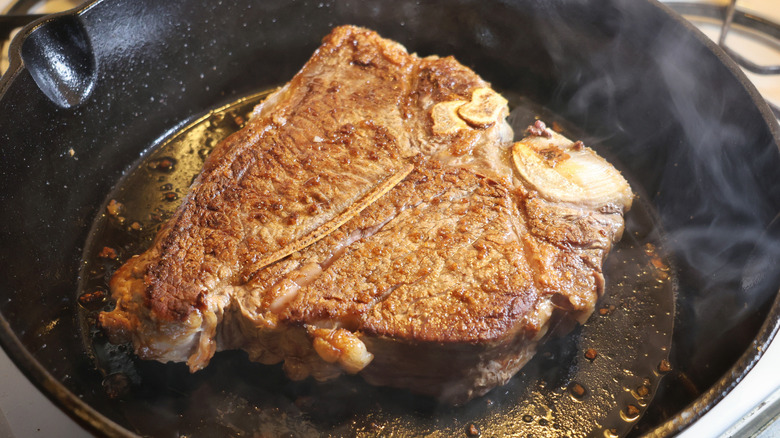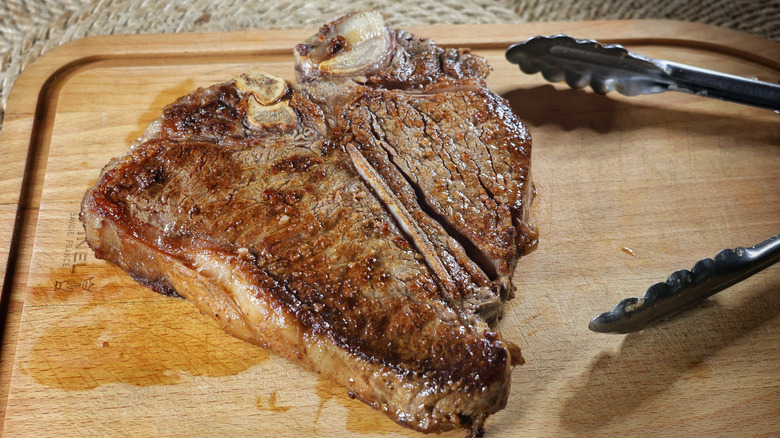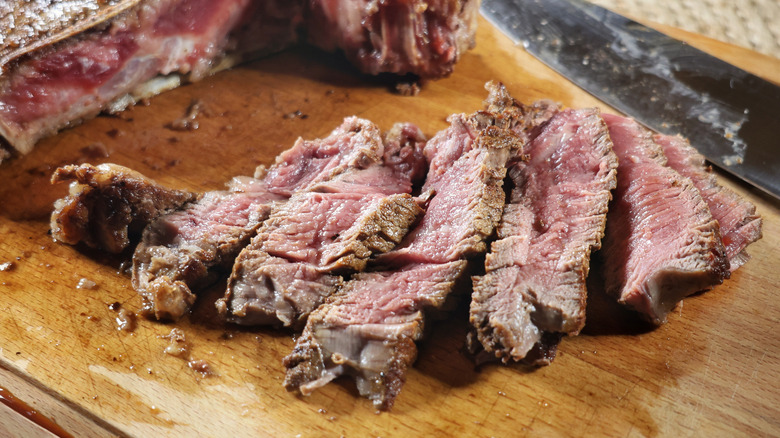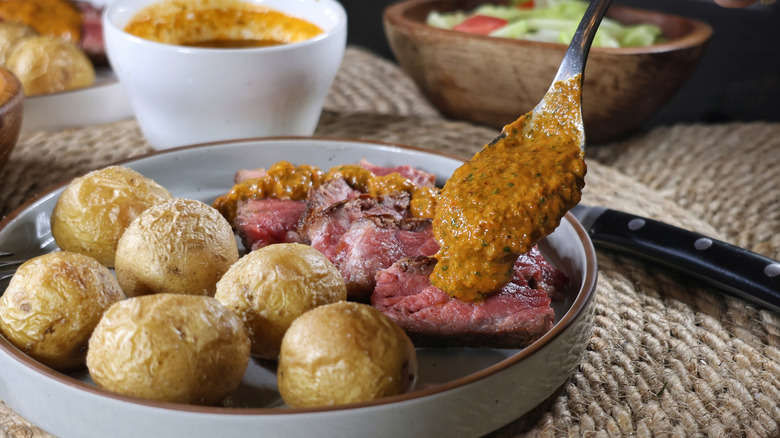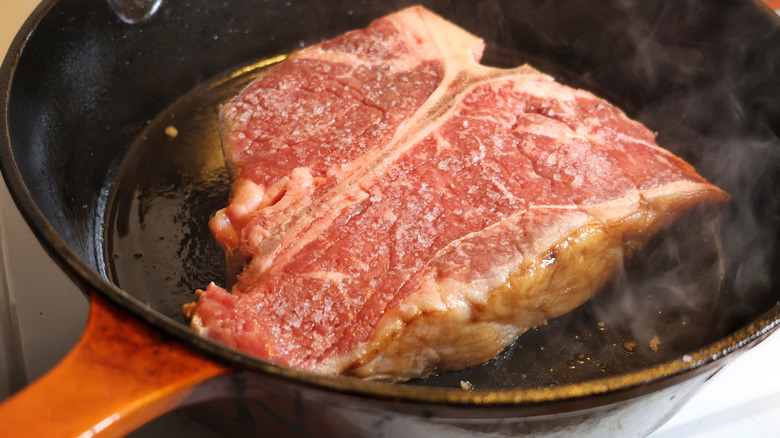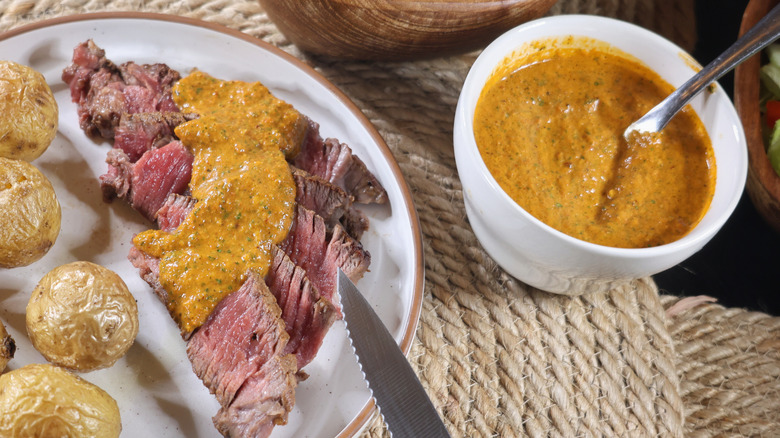T-Bone Steak With Chimichurri Rojo Recipe
A perfectly seared, thick-cut T-bone steak with a deep brown crust and a heavy sprinkle of coarse salt is the sort of thing that dreams are made of. We'd forgive you for thinking that nothing could top those thin slices of tender, savory meat complemented by a bittersweet caramelized crust and a sharp bite of salt — but we are here to tell you that it isn't always a bad thing to gild the lily.
You may not realize it yet, but chimichurri rojo is the sauce upgrade that your steaks were looking for. You have probably heard of the South American sauce chimichurri, you may have even eaten it paired with asado — what with chimichurri and steak being integral parts of Argentinian culinary culture — but chimichurri rojo is the lesser-known and perhaps even more delicious cousin. It takes everything wonderful about chimichurri and tosses in a few more layers of flavor.
Green chimichurri (which people sometimes confuse with pesto) is a sauce that is believed to have originated in Argentina and is traditionally made from fresh herbs (parsley and oregano, generally), garlic, vinegar, and oil — as well as something spicy in some recipes. It is great with steak and also on grilled vegetables or salad. Chimichurri rojo simply builds on this excellent framework, adding fragrant layers of sweetness and smoke in the form of roasted red peppers. If you already like chimichurri, here's the sauce that takes it to the next level.
Gather the steak and chimichurri rojo ingredients
For the chimichurri rojo sauce in this recipe you will need roasted red peppers, garlic, parsley, oregano, crushed red pepper, black pepper, salt, olive oil, and red wine vinegar. The steak is very simple, requiring only a large t-bone steak and plenty of salt.
Step 1: Start the chimichurri rojo
Add all of the chimichurri ingredients to a food processor or blender.
Step 2: Puree the sauce
Puree the sauce to your desired consistency.
Step 3: Salt the meat
Salt the steak on both sides.
Step 4: Heat and grease the pan
Bring a cast-iron pan to high heat and sear the sides of the steak to render the fat cap.
Step 5: Sear the steak
For a large, 2-inch-thick steak, sear it for around 5-6 minutes on each side (for rare), or until it reaches your desired internal temperature.
Step 6: Rest the steak
Remove the steak to a cutting board and allow it to rest for 5 minutes.
Step 7: Slice the meat
Cut the steak away from the bone and slice thinly.
Step 8: Plate and serve
Serve immediately, with plenty of sauce drizzled over, accompanied by roasted potatoes, if desired.
What can I serve with this T bone steak?
T-Bone Steak With Chimichurri Rojo Recipe
Our perfectly-seared T-bone steak is elevated by the addition of a garlicky, tangy chimichurri rojo for an elegant meal that takes only half an hour to prepare.
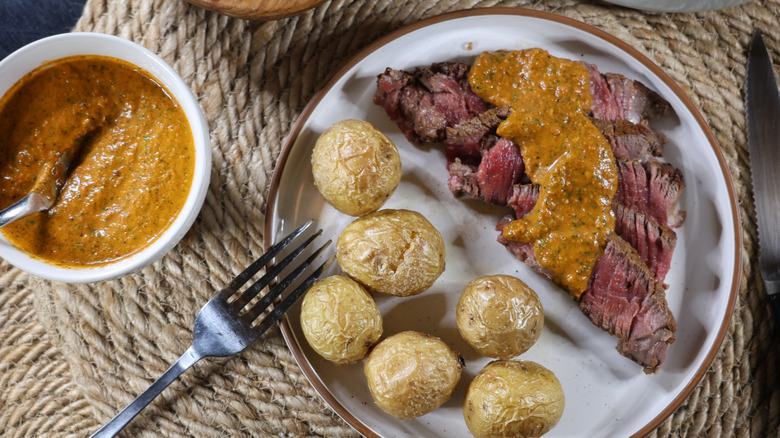
Ingredients
- For the chimichurri rojo
- ½ cup diced roasted red peppers
- ¼ cup roughly chopped parsley
- 3 cloves garlic
- ¼ cup olive oil
- 2 tablespoons red wine vinegar
- ½ teaspoon oregano
- ½ teaspoon black pepper
- ½ teaspoon crushed red pepper
- ¼ teaspoon salt
- For the steak
- 1 (2-pound) t-bone or porterhouse steak
- 1 ½ teaspoons salt
Optional Ingredients
- Roasted potatoes, for serving
Directions
- Add all of the chimichurri ingredients to a food processor or blender.
- Puree the sauce to your desired consistency.
- Salt the steak on both sides.
- Bring a cast-iron pan to high heat and sear the sides of the steak to render the fat cap.
- For a large, 2-inch-thick steak, sear it for around 5-6 minutes on each side (for rare), or until it reaches your desired internal temperature.
- Remove the steak to a cutting board and allow it to rest for 5 minutes.
- Cut the steak away from the bone and slice thinly.
- Serve immediately, with plenty of sauce drizzled over, accompanied by roasted potatoes, if desired.
Nutrition
| Calories per Serving | 513 |
| Total Fat | 39.1 g |
| Saturated Fat | 12.7 g |
| Trans Fat | 1.5 g |
| Cholesterol | 106.5 mg |
| Total Carbohydrates | 2.6 g |
| Dietary Fiber | 0.6 g |
| Total Sugars | 0.8 g |
| Sodium | 631.0 mg |
| Protein | 36.1 g |
Can I use a different cut of beef for this steak recipe?
To pair with the vibrant chimichurri rojo sauce in this recipe, we opted for a primal, bone-in cut. If you don't know about porterhouse steaks, they are very similar to T-bones and come from a similar part of the cow. Both are large, hybrid steaks, offering a delightful variance in texture with plenty of protein to share. We suggest a thick cut for a good sear and rare cook, but as for actually deciding T-bone steak versus porterhouse, well, that's really just down to personal preference — and what your butcher has for you. Both T-bones and porterhouses are in the top three in our ranking of the best cuts of steak for grilling. But you can take this chimichurri rojo just about anywhere.
The first cut of beef we'd suggest substituting for the T-bone or porterhouse would be a ribeye. It is a tender, rich, and heavily marbled cut — and it is the number one cut for grilling in that aforementioned ranking. The bite of the chimichurri rojo is excellent with all steak, but it makes an especially good counterpoint to fattier cuts.
That said, feel free to sub in whatever cut of steak you like to eat. Sirloin and short ribs are both popular cuts for Argentinian asado, so you know they'd go great with this chimichurri rojo. Or you can take a page from this chimichurri steak tacos recipe and drizzle the sauce over thinly-sliced flank steak.
What are other uses for chimichurri rojo sauce?
Chimichurri rojo is just about as good as it gets for a steak sauce. Pungent garlic is paired with sweet and smoky roasted red bell pepper, fresh herbs, red wine vinegar, and olive oil, giving it a rich, tangy, and fragrant backbone, and a spoonful of crushed red pepper adds just enough heat to tingle your lips. It covers all of the flavor bases — with plenty to spare. Once you taste it, you'll understand that while it is great on steak, this sauce can go just about anywhere.
The first place to start with your chimichurri rojo exploration is grilled vegetables. Whatever you are having with your steak — summer squash, asparagus, broccoli — try drizzling it with chimichurri rojo. And then try it on the rest of your plate too. Roasted potatoes are excellent dipped in chimichurri rojo. It even makes a good salad dressing, though you might want to thin it out with a bit of extra olive oil. And we're just getting started. Leftovers the next morning? A dollop of chimichurri is guaranteed to elevate your steak and eggs. Packing your lunch for the day? Chimichurri absolutely belongs on sandwiches. Once you see how easy it is to make and how well it pairs with just about everything, you'll be tempted to keep a jar in your fridge at all times.
